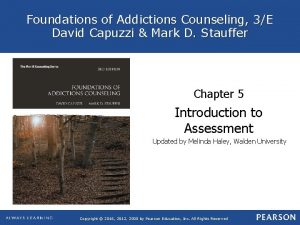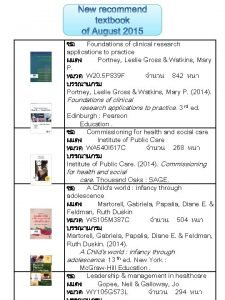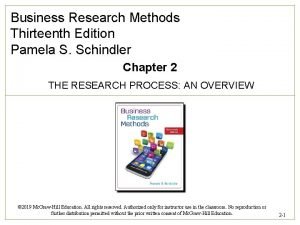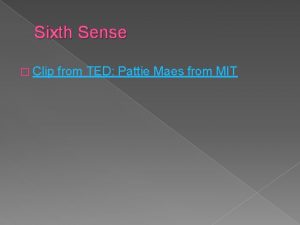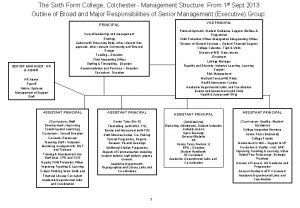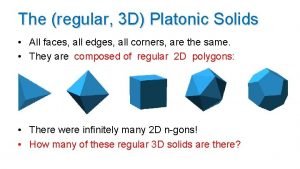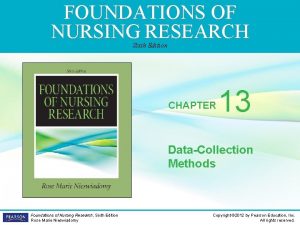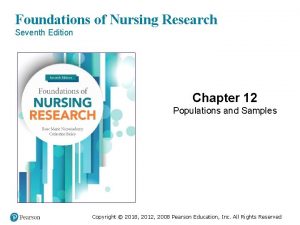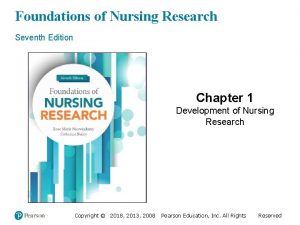FOUNDATIONS OF NURSING RESEARCH Sixth Edition CHAPTER 9
















































































- Slides: 80

FOUNDATIONS OF NURSING RESEARCH Sixth Edition CHAPTER 9 Quantitative Research Designs Foundations of Nursing Research, Sixth Edition Rose Marie Nieswiadomy Copyright © 2012 by Pearson Education, Inc. All rights reserved.

Learning Objectives 1. Identify Criteria For Exploratory, Descriptive, And Explanatory Studies 2. Define Experimental Research 3. Differentiate Between Internal And External Validity In Experimental Designs 4. Identify Six Threats To Internal Validity 5. Identify Three Threats To External Validity Foundations of Nursing Research, Sixth Edition Rose Marie Nieswiadomy Copyright © 2012 by Pearson Education, Inc. All rights reserved.

Learning Objectives 6. Distinguish Among True Experimental, Quasi-Experimental, And Pre. Experimental Designs 7. Describe Three True Experimental Designs 8. Describe Two Quasi-experimental Designs 9. Describe Two Pre-experimental Designs Foundations of Nursing Research, Sixth Edition Rose Marie Nieswiadomy Copyright © 2012 by Pearson Education, Inc. All rights reserved.

Learning Objectives 10. Discuss Four Types Of Nonexperimental Research Designs 11. Recognize Two Types Of Settings In Which Research Is Conducted 12. Identify Factors That Influence The Choice Of Research Designs 13. Critique The Design Section Of Quantitative Studies Foundations of Nursing Research, Sixth Edition Rose Marie Nieswiadomy Copyright © 2012 by Pearson Education, Inc. All rights reserved.

Learning Objective One Identify Criteria For Exploratory, Descriptive, And Explanatory Studies Foundations of Nursing Research, Sixth Edition Rose Marie Nieswiadomy Copyright © 2012 by Pearson Education, Inc. All rights reserved.

Exploratory Studies • • Little known about phenomenon Flexible data collection approach Qualitative and quantitative Hypotheses not appropriate Foundations of Nursing Research, Sixth Edition Rose Marie Nieswiadomy Copyright © 2012 by Pearson Education, Inc. All rights reserved.

Descriptive Studies • • Phenomena described Relationship between variables examined More information about variable(s) Test hypotheses Foundations of Nursing Research, Sixth Edition Rose Marie Nieswiadomy Copyright © 2012 by Pearson Education, Inc. All rights reserved.

Explanatory Studies • Explanations for relationships among phenomena • Rigorous • Experimental research • Control over research conditions • Manipulate one or more variables Foundations of Nursing Research, Sixth Edition Rose Marie Nieswiadomy Copyright © 2012 by Pearson Education, Inc. All rights reserved.

Learning Objective Two Define Experimental Research Foundations of Nursing Research, Sixth Edition Rose Marie Nieswiadomy Copyright © 2012 by Pearson Education, Inc. All rights reserved.

Experimental Research • Cause + effect • Manipulate and control independent variable • Measure dependent variable Foundations of Nursing Research, Sixth Edition Rose Marie Nieswiadomy Copyright © 2012 by Pearson Education, Inc. All rights reserved.

Problems With Experimental Research • Casual relationships difficult to establish • Avoid using word prove • Controls difficult to apply to human beings Foundations of Nursing Research, Sixth Edition Rose Marie Nieswiadomy Copyright © 2012 by Pearson Education, Inc. All rights reserved.

Learning Objective Three Differentiate Between Internal And External Validity In Experimental Designs Foundations of Nursing Research, Sixth Edition Rose Marie Nieswiadomy Copyright © 2012 by Pearson Education, Inc. All rights reserved.

Internal Validity • Degree to which changes in effect can be attributed to cause • Threats – Other factors that influence dependent variable – Constitute rival explanations or competing hypotheses Foundations of Nursing Research, Sixth Edition Rose Marie Nieswiadomy Copyright © 2012 by Pearson Education, Inc. All rights reserved.

External Validity • Degree to which results can be generalized • Questions to ask – With what degree of confidence can findings be transferred to the entire population? – Will these findings hold true with other groups and in other times and places? Foundations of Nursing Research, Sixth Edition Rose Marie Nieswiadomy Copyright © 2012 by Pearson Education, Inc. All rights reserved.

Relationship Between Internal and External Validity • As control for internal increases, external decreases • As concern for external increases, internal may be affected • Need to find balance Foundations of Nursing Research, Sixth Edition Rose Marie Nieswiadomy Copyright © 2012 by Pearson Education, Inc. All rights reserved.

Learning Objective Four Identify Six Threats To Internal Validity Foundations of Nursing Research, Sixth Edition Rose Marie Nieswiadomy Copyright © 2012 by Pearson Education, Inc. All rights reserved.

Six Threats to Internal Validity • • • Selection bias History Maturation Testing Instrumentation change Mortality Foundations of Nursing Research, Sixth Edition Rose Marie Nieswiadomy Copyright © 2012 by Pearson Education, Inc. All rights reserved.

Selection Bias • Results due to subject differences • Not due to independent variable manipulation • Means to control – Random group assignment Foundations of Nursing Research, Sixth Edition Rose Marie Nieswiadomy Copyright © 2012 by Pearson Education, Inc. All rights reserved.

History • Event other than the experimental treatment occurs during the course of study. • Event influences dependent variable. • Means to control – Simultaneous control and comparison groups – Random assignment of subjects to groups Foundations of Nursing Research, Sixth Edition Rose Marie Nieswiadomy Copyright © 2012 by Pearson Education, Inc. All rights reserved.

Maturation • Changes occur within subjects during study. • Changes influence the study results. • Means to control – Simultaneous control and comparison groups Foundations of Nursing Research, Sixth Edition Rose Marie Nieswiadomy Copyright © 2012 by Pearson Education, Inc. All rights reserved.

Testing • Influence of pretest or baseline data knowledge on posttest score Foundations of Nursing Research, Sixth Edition Rose Marie Nieswiadomy Copyright © 2012 by Pearson Education, Inc. All rights reserved.

Instrumentation Change • Difference between pretest and posttest measurement • Caused by change in accuracy rather than experimental treatment • Means to control – Judge training sessions – Trial instrument runs to check for changes – Continue to check instrument accuracy Foundations of Nursing Research, Sixth Edition Rose Marie Nieswiadomy Copyright © 2012 by Pearson Education, Inc. All rights reserved.

Mortality • Subject does not complete study. • Attrition rate different between groups • Means to control – No research design to control – Establish strong researcher-participant relationship Foundations of Nursing Research, Sixth Edition Rose Marie Nieswiadomy Copyright © 2012 by Pearson Education, Inc. All rights reserved.

Learning Objective Five Identify Three Threats To External Validity Foundations of Nursing Research, Sixth Edition Rose Marie Nieswiadomy Copyright © 2012 by Pearson Education, Inc. All rights reserved.

Major Threats to External Validity • Hawthorne effect • Experimenter effect • Reactive effects of the pretest Foundations of Nursing Research, Sixth Edition Rose Marie Nieswiadomy Copyright © 2012 by Pearson Education, Inc. All rights reserved.

Hawthorne Effect • Participants’ responses influenced by knowing they are being observed • Means to control – Double-blind experiment Foundations of Nursing Research, Sixth Edition Rose Marie Nieswiadomy Copyright © 2012 by Pearson Education, Inc. All rights reserved.

Experimenter Effect • Experimental research • Researcher characteristics or behaviors influence subject behaviors. • Examples of influential characteristics – Facial expression – Clothing – Age – Gender – Body build Foundations of Nursing Research, Sixth Edition Rose Marie Nieswiadomy Copyright © 2012 by Pearson Education, Inc. All rights reserved.

Rosenthal Effect • Nonexperimental research • Interviewer characteristics or behaviors influence respondent’s answers. Foundations of Nursing Research, Sixth Edition Rose Marie Nieswiadomy Copyright © 2012 by Pearson Education, Inc. All rights reserved.

Reactive Effects of the Pretest • Subjects sensitized to experimental treatment because of pretest • Examples of pretests – Paper-and-pencil test – Knowledge of baseline data Foundations of Nursing Research, Sixth Edition Rose Marie Nieswiadomy Copyright © 2012 by Pearson Education, Inc. All rights reserved.

Difference Between Internal and External Pretest Threats • Internal threat: pretest or baseline data knowledge cause of posttest results • External threat: pretest or baseline data knowledge catalyst (indirect cause) Foundations of Nursing Research, Sixth Edition Rose Marie Nieswiadomy Copyright © 2012 by Pearson Education, Inc. All rights reserved.

Learning Objective Six Distinguish Among True Experimental, Quasi-Experimental, And Pre-Experimental Designs Foundations of Nursing Research, Sixth Edition Rose Marie Nieswiadomy Copyright © 2012 by Pearson Education, Inc. All rights reserved.

Experimental Research Designs • True experimental • Quasi-experimental • Pre-experimental Foundations of Nursing Research, Sixth Edition Rose Marie Nieswiadomy Copyright © 2012 by Pearson Education, Inc. All rights reserved.

True Experimental Design • Great deal of control • Internal validity threats minimized • Causality inferred with confidence Foundations of Nursing Research, Sixth Edition Rose Marie Nieswiadomy Copyright © 2012 by Pearson Education, Inc. All rights reserved.

True Experimental Design Criteria • Researcher manipulates the experimental variable(s). • One experimental group and one comparison group • Subjects randomly assigned to groups Foundations of Nursing Research, Sixth Edition Rose Marie Nieswiadomy Copyright © 2012 by Pearson Education, Inc. All rights reserved.

Quasi-Experimental Design • No comparison group • Subjects not randomly assigned to groups Foundations of Nursing Research, Sixth Edition Rose Marie Nieswiadomy Copyright © 2012 by Pearson Education, Inc. All rights reserved.

Advantages and Disadvantages of Quasi-Experimental Design • Advantages – Real world more closely approximated • Disadvantages – Not as much control as true experimental design Foundations of Nursing Research, Sixth Edition Rose Marie Nieswiadomy Copyright © 2012 by Pearson Education, Inc. All rights reserved.

Pre-Experimental Design • Considered weak • Researcher has little control. Foundations of Nursing Research, Sixth Edition Rose Marie Nieswiadomy Copyright © 2012 by Pearson Education, Inc. All rights reserved.

Learning Objective Seven Describe Three True Experimental Designs Foundations of Nursing Research, Sixth Edition Rose Marie Nieswiadomy Copyright © 2012 by Pearson Education, Inc. All rights reserved.

Experimental Designs • Pretest-posttest control group design • Posttest-only design • Solomon four-group design Foundations of Nursing Research, Sixth Edition Rose Marie Nieswiadomy Copyright © 2012 by Pearson Education, Inc. All rights reserved.

The Pretest-Posttest Control Group Design • Most frequently used experimental design • Criteria – Subjects randomly assigned to groups – Pretest given to both groups – Experimental group receives experimental treatment. – Comparison group receives routine treatment or no treatment. – Posttest given to both groups Foundations of Nursing Research, Sixth Edition Rose Marie Nieswiadomy Copyright © 2012 by Pearson Education, Inc. All rights reserved.

The Pretest-Posttest Control Group Design (cont’d) • Advantages – Controls for all internal validity threats – Controls for initial differences by adjusting posttest scores statistically • Disadvantages – External threat of reactive effects of the pretest – Can only be generalized to situations in which pretest is administered Foundations of Nursing Research, Sixth Edition Rose Marie Nieswiadomy Copyright © 2012 by Pearson Education, Inc. All rights reserved.

The Posttest-Only Control Group Design • Subjects randomly assigned to groups • Experimental group receives the experimental treatment. • Comparison group receives routine treatment or no treatment. • Posttest given to both groups Foundations of Nursing Research, Sixth Edition Rose Marie Nieswiadomy Copyright © 2012 by Pearson Education, Inc. All rights reserved.

Advantages of Posttest-Only Control Group Design • Easier to carry out • Eliminates reactive effects of the pretest on the posttest Foundations of Nursing Research, Sixth Edition Rose Marie Nieswiadomy Copyright © 2012 by Pearson Education, Inc. All rights reserved.

The Solomon Four-Group Design • All subjects are randomly assigned to one of four groups. – Two groups—experimental group 1 and comparison group 1— pretested – Two groups—experimental group 1 and experimental group 2—receive experimental treatment. – Two groups—comparison group 1 and comparison group 2—receive routine treatment or no treatment. Foundations of Nursing Research, Sixth Edition Rose Marie Nieswiadomy Copyright © 2012 by Pearson Education, Inc. All rights reserved.

Solomon Four-Group Design • Posttest given to all four groups • Advantages – Minimizes threats to both internal and external validity – Differences between groups can be associated with the experimental treatment. • Disadvantages – Requires a large sample – Statistical analysis is complicated. Foundations of Nursing Research, Sixth Edition Rose Marie Nieswiadomy Copyright © 2012 by Pearson Education, Inc. All rights reserved.

Learning Objective Eight Describe Two Quasi-Experimental Designs Foundations of Nursing Research, Sixth Edition Rose Marie Nieswiadomy Copyright © 2012 by Pearson Education, Inc. All rights reserved.

Quasi-Experimental Designs • Nonequivalent control group design • Time-series design Foundations of Nursing Research, Sixth Edition Rose Marie Nieswiadomy Copyright © 2012 by Pearson Education, Inc. All rights reserved.

The Nonequivalent Control Group Design • Similar to pretest-posttest control group design • No random assignment of subjects to groups Foundations of Nursing Research, Sixth Edition Rose Marie Nieswiadomy Copyright © 2012 by Pearson Education, Inc. All rights reserved.

Internal Validity in Nonequivalent Control Group Design • Threats to internal validity controlled – History – Testing – Maturation – Instrumentation change • Threats to internal validity that remain – Selection bias Foundations of Nursing Research, Sixth Edition Rose Marie Nieswiadomy Copyright © 2012 by Pearson Education, Inc. All rights reserved.

Time-Series Design • Periodic observations or measurements of subjects • Experimental treatment administered between two of the observations Foundations of Nursing Research, Sixth Edition Rose Marie Nieswiadomy Copyright © 2012 by Pearson Education, Inc. All rights reserved.

Time-Series Design • Advantages – Numerous observations or measurements of dependent variable – Strengthens validity • Disadvantages – Internal validity threats: history and testing Foundations of Nursing Research, Sixth Edition Rose Marie Nieswiadomy Copyright © 2012 by Pearson Education, Inc. All rights reserved.

Learning Objective Nine Describe Two Pre-Experimental Designs Foundations of Nursing Research, Sixth Edition Rose Marie Nieswiadomy Copyright © 2012 by Pearson Education, Inc. All rights reserved.

Pre-Experimental Designs • One-shot case study • One-group pretest-posttest design Foundations of Nursing Research, Sixth Edition Rose Marie Nieswiadomy Copyright © 2012 by Pearson Education, Inc. All rights reserved.

The One-Shot Case Study • Single group exposed to experimental treatment • Observed after treatment • Weak design • Doesn’t control for threats to internal validity Foundations of Nursing Research, Sixth Edition Rose Marie Nieswiadomy Copyright © 2012 by Pearson Education, Inc. All rights reserved.

The One-Group Pretest-Posttest Design • Comparison between a group of subjects before and after experimental treatment • Threats to internal validity – History – Maturation – Testing – Instrumentation change Foundations of Nursing Research, Sixth Edition Rose Marie Nieswiadomy Copyright © 2012 by Pearson Education, Inc. All rights reserved.

Learning Objective Ten Discuss Four Types Of Nonexperimental Research Designs Foundations of Nursing Research, Sixth Edition Rose Marie Nieswiadomy Copyright © 2012 by Pearson Education, Inc. All rights reserved.

Nonexperimental Research • Describes phenomena as it exists • No manipulation • No control of variables Foundations of Nursing Research, Sixth Edition Rose Marie Nieswiadomy Copyright © 2012 by Pearson Education, Inc. All rights reserved.

Nonexperimental Research (cont’d) • • Survey research Correlational research Comparative research Methodological research Foundations of Nursing Research, Sixth Edition Rose Marie Nieswiadomy Copyright © 2012 by Pearson Education, Inc. All rights reserved.

Survey Research • Self-report data – Phone – Mail – Internet – Personal contacts Foundations of Nursing Research, Sixth Edition Rose Marie Nieswiadomy Copyright © 2012 by Pearson Education, Inc. All rights reserved.

Strengths of Survey Research • Advantages – Provide accurate information on populations – Use relatively small samples – Collect large amounts of data quickly – Minimal cost • Disadvantages – Responses may be unreliable. Foundations of Nursing Research, Sixth Edition Rose Marie Nieswiadomy Copyright © 2012 by Pearson Education, Inc. All rights reserved.

Correlational Research • Examines strength of relationship between two or more variables • How is change in one variable associated with changes in another? Foundations of Nursing Research, Sixth Edition Rose Marie Nieswiadomy Copyright © 2012 by Pearson Education, Inc. All rights reserved.

Correlational Coefficient • Indicates the strength and direction of relationships • Indicates positive (+) or negative (–) information – +1. 00: perfect positive correlation – – 1. 00: perfect negative correlation – 0. 00: no correlation or relationship Foundations of Nursing Research, Sixth Edition Rose Marie Nieswiadomy Copyright © 2012 by Pearson Education, Inc. All rights reserved.

Comparative Studies • Examines differences between groups on dependent variable • No manipulation of the independent variable Foundations of Nursing Research, Sixth Edition Rose Marie Nieswiadomy Copyright © 2012 by Pearson Education, Inc. All rights reserved.

Two Types of Comparative Studies • Retrospective or ex post facto – Examine an effect – Look back in time to determine cause • Prospective – Determination of a cause – Looks forward in time to determine effect on subjects Foundations of Nursing Research, Sixth Edition Rose Marie Nieswiadomy Copyright © 2012 by Pearson Education, Inc. All rights reserved.

Prospective Studies • Advantages – Experimental approach – Manipulate independent variable • Prospective – Costly Foundations of Nursing Research, Sixth Edition Rose Marie Nieswiadomy Copyright © 2012 by Pearson Education, Inc. All rights reserved.

Methodological Studies • Research instruments and methods – Development – Testing – Evaluation • Seen with increasing frequency • Develop stockpile of nursing-appropriate instruments Foundations of Nursing Research, Sixth Edition Rose Marie Nieswiadomy Copyright © 2012 by Pearson Education, Inc. All rights reserved.

Secondary Analysis Studies • • • Analyses data gathered in previous study Test new hypotheses Ask new research questions Cost effective Efficient Foundations of Nursing Research, Sixth Edition Rose Marie Nieswiadomy Copyright © 2012 by Pearson Education, Inc. All rights reserved.

Learning Objective Eleven Recognize Two Types Of Settings In Which Research Is Conducted Foundations of Nursing Research, Sixth Edition Rose Marie Nieswiadomy Copyright © 2012 by Pearson Education, Inc. All rights reserved.

Research Settings • Laboratory studies • Field studies Foundations of Nursing Research, Sixth Edition Rose Marie Nieswiadomy Copyright © 2012 by Pearson Education, Inc. All rights reserved.

Laboratory Studies • Conducted in specially created environments • Research environment controlled by researcher Foundations of Nursing Research, Sixth Edition Rose Marie Nieswiadomy Copyright © 2012 by Pearson Education, Inc. All rights reserved.

Field Studies • Real-life setting • Little control maintained by researcher • Very appropriate for nursing research Foundations of Nursing Research, Sixth Edition Rose Marie Nieswiadomy Copyright © 2012 by Pearson Education, Inc. All rights reserved.

Learning Objective Twelve Identify Factors That Influence The Choice Of Research Designs Foundations of Nursing Research, Sixth Edition Rose Marie Nieswiadomy Copyright © 2012 by Pearson Education, Inc. All rights reserved.

Cause and Effect Versus Describing a Phenomenon • Cause-and-effect research designs – Experimental designs • Describing a phenomenon research designs – Nonexperimental designs Foundations of Nursing Research, Sixth Edition Rose Marie Nieswiadomy Copyright © 2012 by Pearson Education, Inc. All rights reserved.

Level of Control • Least control – Pre-experimental designs • More control – Quasi-experimental designs • Most control – True experimental designs Foundations of Nursing Research, Sixth Edition Rose Marie Nieswiadomy Copyright © 2012 by Pearson Education, Inc. All rights reserved.

Other Determinant Factors • Cost effective – Secondary analysis studies – Survey research • Costly – Prospective studies • Ethical reasons – Nonexperimental comparative studies Foundations of Nursing Research, Sixth Edition Rose Marie Nieswiadomy Copyright © 2012 by Pearson Education, Inc. All rights reserved.

Learning Objective Thirteen Critique The Design Section Of Quantitative Studies Foundations of Nursing Research, Sixth Edition Rose Marie Nieswiadomy Copyright © 2012 by Pearson Education, Inc. All rights reserved.

Critique of Quantitative Research Designs • Read the entire research report carefully • Determine if the appropriate design is used Foundations of Nursing Research, Sixth Edition Rose Marie Nieswiadomy Copyright © 2012 by Pearson Education, Inc. All rights reserved.

Questions for Critique of the Design Section of Quantitative Studies • Is the design clearly identified and described? • Is the design appropriate to test the hypothesis or hypotheses or research question(s)? • If an experimental design was used, was it appropriate? Foundations of Nursing Research, Sixth Edition Rose Marie Nieswiadomy Copyright © 2012 by Pearson Education, Inc. All rights reserved.

Questions for Critique of the Design Section of Quantitative Studies • If an experimental design was used, what means were used to control for threats to internal and external validity? • Was the assignment of subjects to experimental and control groups clearly described? • Does the research design allow the researcher to draw a cause-and-effect relationship between the variables? Foundations of Nursing Research, Sixth Edition Rose Marie Nieswiadomy Copyright © 2012 by Pearson Education, Inc. All rights reserved.

Questions for Critique of the Design Section of Quantitative Studies • If a nonexperimental design was used, would an experimental design have been more appropriate? • If a nonexperimental design was used, what means were used to control for extraneous variables? Foundations of Nursing Research, Sixth Edition Rose Marie Nieswiadomy Copyright © 2012 by Pearson Education, Inc. All rights reserved.
 Peter pickle tongue twister
Peter pickle tongue twister The sixth sick sheik's sixth sheep's sick lyrics
The sixth sick sheik's sixth sheep's sick lyrics Biochemistry sixth edition 2007 w.h. freeman and company
Biochemistry sixth edition 2007 w.h. freeman and company Computer architecture a quantitative approach sixth edition
Computer architecture a quantitative approach sixth edition Automotive technology principles diagnosis and service
Automotive technology principles diagnosis and service Automotive technology sixth edition
Automotive technology sixth edition Apa sixth edition
Apa sixth edition Computer architecture a quantitative approach sixth edition
Computer architecture a quantitative approach sixth edition Precalculus sixth edition
Precalculus sixth edition Principles of economics sixth edition
Principles of economics sixth edition Computer architecture a quantitative approach sixth edition
Computer architecture a quantitative approach sixth edition Foundations of business 5th edition
Foundations of business 5th edition Foundations of addictions counseling
Foundations of addictions counseling Sunrise enabler
Sunrise enabler Foundations of clinical research applications to practice
Foundations of clinical research applications to practice Using mis (10th edition) 10th edition
Using mis (10th edition) 10th edition Chapter 1
Chapter 1 Modes of speciation ppt
Modes of speciation ppt What are the three c's of healthy relationships
What are the three c's of healthy relationships Chapter 6 lesson 1 foundations of a healthy relationship
Chapter 6 lesson 1 foundations of a healthy relationship Chapter 2 foundations of resident care
Chapter 2 foundations of resident care Foundations of individual behaviour
Foundations of individual behaviour Chapter 1: foundations of government worksheet answers
Chapter 1: foundations of government worksheet answers Chapter 4 foundations background to american history
Chapter 4 foundations background to american history Chapter 1: introduction to personal finance answer key
Chapter 1: introduction to personal finance answer key Foundations of government vocabulary
Foundations of government vocabulary Chapter 1: foundations of government pdf
Chapter 1: foundations of government pdf Foundations of government (chapter 1 test form a)
Foundations of government (chapter 1 test form a) Nursing research definition
Nursing research definition Professional nursing practice 7th edition
Professional nursing practice 7th edition Business research methods 13th edition
Business research methods 13th edition The fundamentals of political science research 2nd edition
The fundamentals of political science research 2nd edition Nuast sixth form
Nuast sixth form Sixth form college windsor
Sixth form college windsor Wolf of shenfield
Wolf of shenfield Ela transitions
Ela transitions The six chief commandments of the catholic church
The six chief commandments of the catholic church Dante circles of hell
Dante circles of hell Latymer sixth form
Latymer sixth form Crossley heath term dates
Crossley heath term dates Sixth state of matter
Sixth state of matter 6th sunday of easter year c
6th sunday of easter year c Ted sixth sense
Ted sixth sense Little heath sixth form
Little heath sixth form Hamlet 7th soliloquy
Hamlet 7th soliloquy Brighouse high open evening
Brighouse high open evening Blackfen sixth form
Blackfen sixth form Sixth sense technology seminar report
Sixth sense technology seminar report Barry 6th form
Barry 6th form Sixth freedom traffic
Sixth freedom traffic Solihull sixth form tyber
Solihull sixth form tyber Bfs sixth form
Bfs sixth form Walton high sixth form application
Walton high sixth form application Walton high sixth form application
Walton high sixth form application Paths to god
Paths to god Sixth avenue medical pharmacy
Sixth avenue medical pharmacy Shenfield sixth form
Shenfield sixth form In the sixth month angel gabriel
In the sixth month angel gabriel The sixth and ninth commandments
The sixth and ninth commandments Winchmore sixth form open evening
Winchmore sixth form open evening Wickersley 6th form
Wickersley 6th form Chesterton community college open evening
Chesterton community college open evening Walton high sixth form
Walton high sixth form Explain about iot design methodology
Explain about iot design methodology The sixth sense cinematography
The sixth sense cinematography Colchester sixth form college open evening
Colchester sixth form college open evening The fifth, sixth, seventh, and eighth amendments protect *
The fifth, sixth, seventh, and eighth amendments protect * Sixth sense technology seminar
Sixth sense technology seminar Mill hill sixth form
Mill hill sixth form Sixth and seventh commandments
Sixth and seventh commandments Kesgrave high school
Kesgrave high school Park hall sixth form
Park hall sixth form Platonic solids 4d
Platonic solids 4d Sixth sense
Sixth sense Bioengineering sixth sense
Bioengineering sixth sense Shenfield high school sixth form
Shenfield high school sixth form Park hall sixth form
Park hall sixth form Nhgs sixth form
Nhgs sixth form Charter school sixth form
Charter school sixth form St michael's catholic college sixth form
St michael's catholic college sixth form 100 to the sixth power
100 to the sixth power












